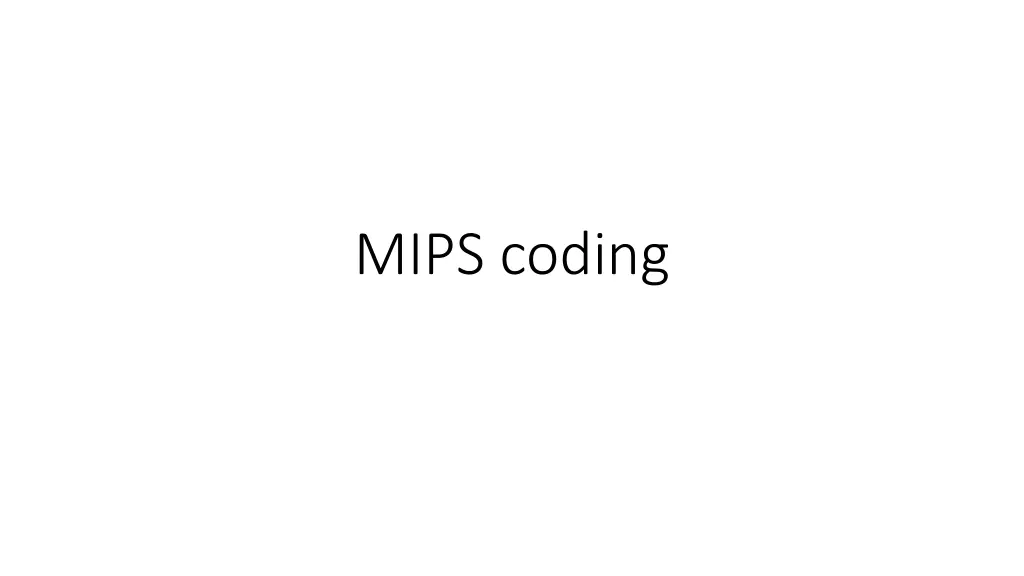
Understanding MIPS Architecture and Assembly Language
Explore questions and examples related to MIPS coding, including binary instruction interpretation, opcode fields, instruction correctness, address storage in instructions, program counter behavior, and loop translation. Learn about compiling while loops in C and executing instructions in MIPS assembly language.
Download Presentation

Please find below an Image/Link to download the presentation.
The content on the website is provided AS IS for your information and personal use only. It may not be sold, licensed, or shared on other websites without obtaining consent from the author. If you encounter any issues during the download, it is possible that the publisher has removed the file from their server.
You are allowed to download the files provided on this website for personal or commercial use, subject to the condition that they are used lawfully. All files are the property of their respective owners.
The content on the website is provided AS IS for your information and personal use only. It may not be sold, licensed, or shared on other websites without obtaining consent from the author.
E N D
Presentation Transcript
Questions If $t0 is holding 30, in the binary of instruction add $t2, $t0, $t1, the rs field should be 30?
Questions Is it true that because the j instruction has to specify the entire address, it has a smaller opcode field?
Questions Is it correct to write an instruction addi $t0, $t0, 100000?
Questions Is it true that instruction beq $t0, $t1, L1 does not store the entire address associated with L1 but the offset with respect to its own address?
Questions Is it true that the PC (program counter) always stores the address of the current instruction, except when encountering beq, bne, and j?
Questions beq $t0, 5, L1 It would be nice if we have an instruction like which compares $t0 with the constant 5 and jumps if they are the same. Does MIPS have this instruction? Why?
Loop example 2 How to translate the following to MIPS assembly? We first translate into a C program using if and goto 6/28/2025 week04-3.ppt 8
Compiling a while loop in C Assume that i and k correspond to registers $s3 and $s5 and starting address of array save is in $s6 6/28/2025 week04-3.ppt 9
Compiling a while loop in C Assume that i and k correspond to registers $s3 and $s5 and starting address of array save is in $s6 6/28/2025 week04-3.ppt 10
While Loop How many instructions will be executed for the following array save? Assume that k = 10 and i = 0 initially 6/28/2025 week04-3.ppt 11
Optimized How many instructions now? Assume k = 10 and i = 0 initially 6/28/2025 week04-3.ppt 12
The loop code .data save:.word 10, 10, 10, 10, 10, 11, 12, main: Loop: Exit: .text .globl main li $s3, 0 li $s5, 10 la $s6, save sll $t1, $s3, 2 add $t1, $t1, $s6 lw $t0, 0($t1) bne $t0, $s5, Exit addi $s3, $s3, 1 j Loop done: li $v0, 10 # these two lines are to tell the simulator to stop syscall
Loop Example 3 Finding the largest element in an array The idea is to use a register, say, $t9, to keep the largest number we have seen so far, go through the array, if encounter a number larger than the one in $t9, replace $t9 with this number
Loop ex 3 data .word 12, 34, 67, 1, 45, 90, 11, 33, 67, 19 A: main: LOOP: LOOP_NEXT: addi $t0, $t0, 1 bne $t0, $s1, LOOP done: li $v0,10 syscall .text .globl main la $s0, A li $s1, 10 li $t0, 0 li $t9, 0 # number of elements in the array # $t0 as i # $t9 as the max number sll $t1, $t0, 2 add $t1, $t1, $s0 lw $t1, 0($t1) slt $t2, $t9, $t1 beq $t2, $0, LOOP_NEXT ori $t9, $t1, 0 # these 3 instructions read A[i] into $t1 # compare $t1 with $t9, $t2 should be 1 if $t9 is smaller # if $t2 is 0, means $t9 is larger than $t1, nothing needs to be done # if came here, $t2 is 1, replace $t9 with $t1 # increment i by 1 # if i!=$s1, continue to the next element in the array # these two lines tell the simulator to stop
